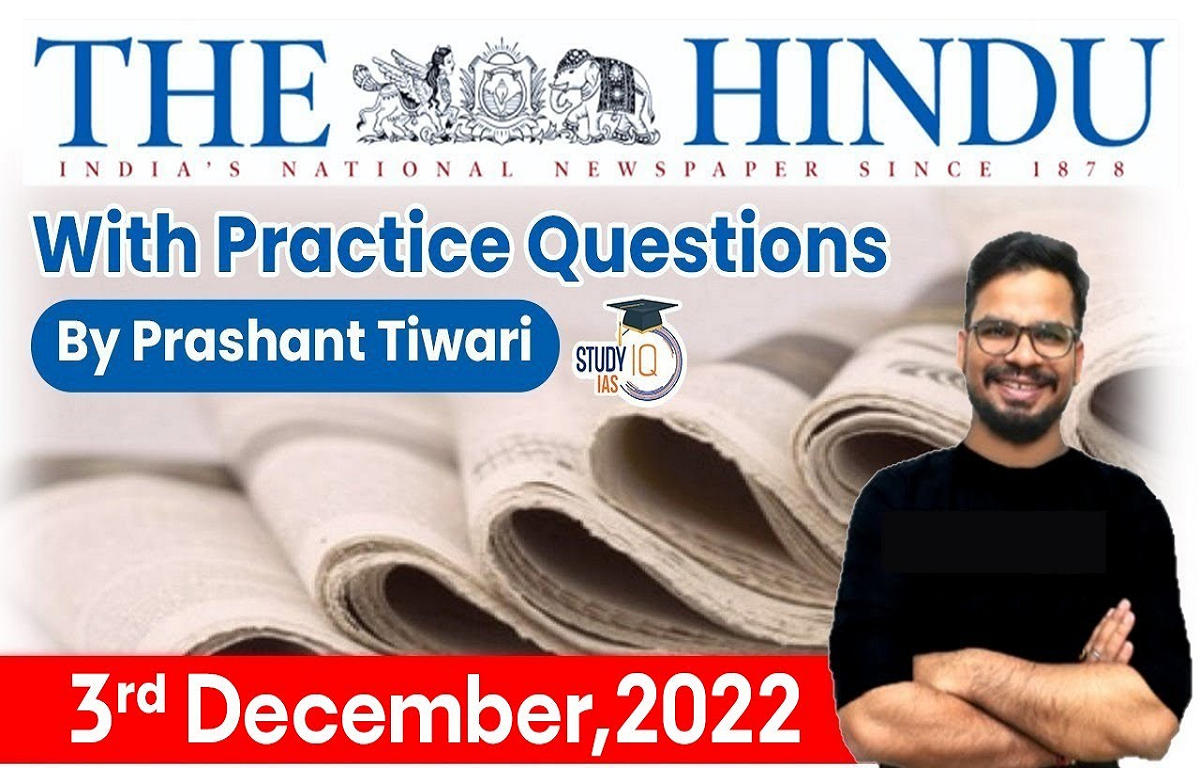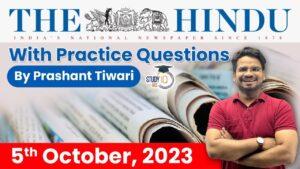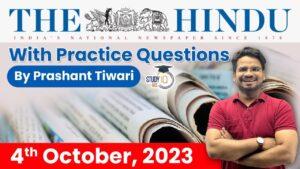The Hindu Newspaper Analysis for UPSC

The Hindu Newspaper Analysis 2 December 2022
- The Supreme Court on Friday quashed the anticipatory bail granted by the Kerala High Court to former police and intelligence officers, including retired Kerala Director General of Police Siby Mathews, accused of being part of a conspiracy to frame ISRO scientist Nambi Narayanan in an espionage case in 1994.
- A Bench led by Justice M.R. Shah remitted the anticipatory bail applications of the accused to the High Court for fresh consideration. The top court, in its judgment, directed the High Court Registry to list the case before the High Court Bench concerned within a week from December 2. The High Court was asked to hear and finally decide the case at the earliest but not outside four weeks’ time.
What is the ISRO spy scandal case?
- A Maldivian woman was arrested in India in 1994 and was suspected to sell secrets from ISRO scientists to Pakistan.
- Three scientists were arrested on charges of sharing official secrets on space technology and launch missions.
- Narayanan was one of the three arrested by the Kerala Police in November, 1994.
- He was the director of cryogenic engine technology at Indian Space Research Organisation (ISRO).
- The police accused him of passing on documents and drawings of ISRO to Pakistan.
- This was in relation with Vikas engine technology (Indian version of France’s Viking engine), cryogenic engine technology and PSLV flight data/drawings.
- Soon, the Central Bureau of Investigation (CBI) took over the probe from the police.
- The CBI, in 1996, recommended closure of the case, citing complete lack of evidence.
- It also pointed to the grave lapses in the police probe which used questionable methods and proceeded on nothing but suspicion.
- Ever since the proceedings were dropped, Mr. Narayanan has fought to bring his accusers to justice.

- Since 2018, India’s ‘Look East’ and ‘Act East’ policies have moved into the phase of Indo-Pacific policy and strategy.
- There, the more important issues still are the need to ensure adequate security, speed up economic development, and connect better with the rest of India and select South Asian and Southeast Asian nations. Hence, an effective way to work for a ‘free, open, inclusive, peaceful and prosperous’ Indo-Pacific is to see how these five characteristics may be made more applicable to our eastern region.
- The Northeast which comprises seven ‘sisters’ or States and one ‘brother’, Sikkim, has been witnessing transformation as it heads towards better security conditions and development. Recent participation in policy conversations in Imphal, the capital of Manipur, one of the four States bordering Myanmar (Arunachal Pradesh, Nagaland and Mizoram are the others) — helped in clarifying local needs and priorities.
- Thus, beyond ‘Look East’ and ‘Act East’ lies ‘Think and Relate East’, especially within our own country.
- The Bay of Bengal Initiative for Multi-Sectoral Technical and Economic Cooperation (BIMSTEC) is a regional multilateral organisation.
- Its members lie in the littoral and adjacent areas of the Bay of Bengal constituting a contiguous regional unity.
- Out of the 7 members,
- Five are from South Asia –
- Bangladesh, Bhutan ,India, Nepal, Sri Lanka
- Two are from Southeast Asia –
- Myanmar, Thailand
- Five are from South Asia –
This sub-regional organization came into being in 1997 through the Bangkok Declaration.
- Initially, it was formed with four Member States with the acronym ‘BIST-EC’ (Bangladesh, India, Sri-Lanka and Thailand Economic Cooperation).
- It became renamed ‘BIMST-EC’ in 1997, following the inclusion of Myanmar.
- With the admission of Nepal and Bhutan in 2004, the name of the grouping was changed to ‘Bay of Bengal Initiative for Multi-Sectoral Technical and Economic Cooperation’ (BIMSTEC).

- The Government launched its year of the G-20 presidency on December 1 with some pomp, and 100 monuments from Kashmir to Kanyakumari lit up with India’s G-20 logo symbolising the motto “Vasudhaiva Kutumbakam, or “one earth, one family, one future”.
- Symbolism and logistical coordination aside, the Government has a tough task ahead in conducting substantive negotiations to bring together a comprehensive G-20 agenda, where officials said they would focus on counter-terrorism, supply chain disruptions and global unity.
- At a time India itself faces economic distress and social and communal tensions, the Government should be prepared for more scrutiny on upholding such ideals. Having raised the pitch on India’s global prominence as G-20 President, and its power to shape the global narrative, the Government may find that with great power comes great responsibility, and a greater spotlight on its ability to translate its global dreams into the domestic landscape as well.
What is the G20?
- About:
- The G20 was formed in 1999 in the backdrop of the financial crisis of the late 1990s that hit East Asia and Southeast Asia in particular.
- It aims to secure global financial stability by involving middle-income countries.
- Members:
- Argentina, Australia, Brazil, Canada, China, France, Germany, India, Indonesia, Italy, Japan, Republic of Korea, Mexico, Russia, Saudi Arabia, South Africa, Turkey, the United Kingdom, the United States and the EU.

- Vice-President Jagdeep Dhankhar has said that the world does not know of an instance where a Constitution provision, reflecting the will of people, can be undone by the judiciary.
- Though the Vice-President did not explicitly name the Constitutional amendment, his reference was to the now-repealed National Judicial Appointments Commission (NJAC) through the 99th
- The NJAC — that sought to replace the collegium system of appointing judges to the higher judiciary — was passed unanimously in the Lok Sabha. However, it was struck down as unconstitutional by the Supreme Court in October 2015.
- Our Indian Constitution provides in explicit terms Art 145 (3). Interpretation of the Constitution when a substantial question of law is involved can be done by the court. Nowhere it says that a provision can be run down,” he said,

- One thousand tourist guides, including 146 who can speak foreign languages, would fan out across the 55 locations where G-20 meetings would be held over the next one year to facilitate the travel of foreign delegates and “ensure a unique Indian experience” for them.
- The training of the tourist guides is being done through the Indian Institute of Tourism and Travel Management and Regional Directors from the Ministry of Tourism.
- A major part of the training would include language skill programmes in nine foreign languages like French and German. Other focus areas would be etiquette, knowledge of local attractions and monuments, cuisines, handicrafts and souvenirs.

- Heeding to persistent complaints from Mates or site supervisors that their wages under the Mahatma Gandhi National Rural Employment Guarantee Scheme (MGNREGS) are inordinately delayed, the Union Rural Development Ministry has devised a protocol to prioritise payment to mates.
- Under the MGNREGS, wages of unskilled workers have to be paid within 15 days and if there is a delay, the Centre has to compensate them. Mates — who are the frontline supervisors of the programme — are listed as semi-skilled workers because of the specialist nature of their job. What should have been a leg-up for them has unfortunately ended up being a complication.
Q) Which of the following states have legislative council?
- Maharashtra
- Tamil Nadu
- Telangana
- Punjab
- Andhra Pradesh
Select the correct answer code:
- 1, 2, 3, 4
- 1, 3, 4, 5
- 1, 3, 5
- 2, 3, 4, 5
निम्नलिखित में से किस राज्य में विधान परिषद है?
- महाराष्ट्र
- तमिलनाडु
- तेलंगाना
- पंजाब
- आंध्र प्रदेश
सही उत्तर कूट का चयन करें:
- 1, 2, 3, 4
- 1, 3, 4, 5
- 1, 3, 5
- 2, 3, 4, 5
- Andhra Pradesh, Bihar, Karnataka, Maharashtra, Telangana and UP have a legislative council.
Q) Weddell Sea, recently seen in news is part of
- Atlantic Ocean
- Pacific Ocean
- Southern Ocean
- Arctic Ocean
हाल ही में खबरों में रहे वेडेल सी का हिस्सा है
- अटलांटिक महासागर
- प्रशांत महासागर
- दक्षिणी महासागर
- आर्कटिक महासागर
The Weddell Sea is part of the Southern Ocean.

Q) Carbon Capture Utilization Storage (CCUS) is the process of
- Capturing waste carbon dioxide from large point sources and reusing it
- Redistributing captured carbon from storage in the atmosphere to mitigate de-calcification in marine sources
- Generating carbon certificates from carbon-intensive activities and issuing them based on the carbon footprint associated with each such activity
- Destroying atmospheric CO2 by way of electrostatic precipitators and storing the residue in specialized storages
कार्बन कैप्चर यूटिलाइजेशन स्टोरेज (CCUS) की प्रक्रिया है
- बड़े बिंदु स्रोतों से अपशिष्ट कार्बन डाइऑक्साइड को पकड़ना और उसका पुन: उपयोग करना
- समुद्री स्रोतों में डी-कैल्सीफिकेशन को कम करने के लिए वातावरण में भंडारण से पकड़े गए कार्बन का पुनर्वितरण करना
- कार्बन-गहन गतिविधियों से कार्बन प्रमाणपत्र बनाना और ऐसी प्रत्येक गतिविधि से जुड़े कार्बन फुटप्रिंट के आधार पर उन्हें जारी करना
- इलेक्ट्रोस्टैटिक प्रीसिपिटेटर्स के माध्यम से वायुमंडलीय सीओ 2 को नष्ट करना और विशेष भंडारण में अवशेषों को संग्रहित करना
Explanation:
- Carbon capture utilization storage is the process of capturing waste carbon dioxide (CO2) from large point sources, such as fossil fuel power plants, and either transporting it to a storage site where it will not enter the atmosphere, normally an underground geological formation, or reusing it.
- In Carbon Capture and Storage (CCS), emissions are forced into underground rocks at great cost and no economic benefit while CCUS aims at using CO2 emissions by exploiting the resource itself and creating new markets around it.
Q) Right to Privacy is protected as an intrinsic part of Right to Life and Personal Liberty. Which of the following in the Constitution of India correctly and appropriately imply the above statement?
- Article 14 and the provisions under the 42nd Amendment to the Constitution
- Article 17 and the Directive Principles of State Policy in Part IV.
- Article 21 and freedom guaranteed in part III
- Article 24 and provisions under the 44th Amendment to the constitution.
निजता के अधिकार को जीवन और व्यक्तिगत स्वतंत्रता के अधिकार के आंतरिक भाग के रूप में संरक्षित किया गया है। भारत के संविधान में निम्नलिखित में से कौन सा उपरोक्त कथन को सही और उचित रूप से लागू करता है?
- अनुच्छेद 14 और संविधान के 42वें संशोधन के तहत प्रावधान
- अनुच्छेद 17 और भाग IV में राज्य नीति के निर्देशक सिद्धांत।
- अनुच्छेद 21 और भाग III में स्वतंत्रता की गारंटी
- अनुच्छेद 24 और संविधान के 44वें संशोधन के तहत प्रावधान।
Explanation:
- Privacy is a constitutionally protected right which emerges primarily from the guarantee of life and personal liberty in Article 21 of the Constitution. Elements of privacy also arise in varying contexts from the other facets of freedom and dignity recognized and guaranteed by the fundamental rights contained in Part III.
Q) Consider the following statements.
- Carbon neutrality refers to achieving net zero carbon dioxide emissions.
- Carbon neutrality can be achieved only by eliminating carbon dioxide emissions altogether.
- Renewable energy always produces zero carbon emissions.
Which of the statements given above is/are not true?
- 2 only
- 1, 2 and 3
- Neither 2 nor 3
- Neither 1 nor 2
निम्नलिखित कथनों पर विचार करें।
- कार्बन तटस्थता का तात्पर्य शुद्ध शून्य कार्बन डाइऑक्साइड उत्सर्जन को प्राप्त करना है।
- कार्बन डाइऑक्साइड उत्सर्जन को पूरी तरह समाप्त करके ही कार्बन तटस्थता प्राप्त की जा सकती है।
- नवीकरणीय ऊर्जा हमेशा शून्य कार्बन उत्सर्जन पैदा करती है।
ऊपर दिए गए कथनों में से कौन सा/से सत्य नहीं है/हैं?
- केवल 2
- 1, 2 और 3
- न तो 2 और न ही 3
- न तो 1 और न ही 2
Explanation:
- Carbon neutrality refers to achieving net zero carbon dioxide emissions by balancing carbon dioxide emissions with removal (often through carbon offsetting) or simply eliminating carbon dioxide emissions altogether (the transition to the “post-carbon economy”).
- Although both renewable and non-renewable energy both produce carbon emissions in some form, renewable energy has a lesser to almost zero carbon emissions.
Mains Practice Question:
Q) Explore and evaluate the impact of ‘Work From Home’ on family relationships. (150 words)
पारिवारिक रिश्तों पर ‘घर से काम’ के प्रभाव का अन्वेषण और मूल्यांकन करें। (150 शब्द)
Introduction:
- “Work From Home” culture increased since the COVID pandemic. WFH is currently known as an alternative working to minimize the risk of COVID-19 infection. However, WFH is not new and has been brought to the attention of several schools of thought for many years. The WFH concept was initially mentioned by Nilles (1988) dating back to 1973, known as “telecommuting” or “telework”.
- WFH has been defined in various terms over the four decades, namely remote work, flexible workplace, telework, telecommuting, e–working.
Body:
POSITIVE IMPACT-
- While working from home a person spends more time with family. This makes the family bond stronger.
- Parents spend more time with children which is good for parent-children relationships.
- While working from home you can take better care of your sick elderly parents.
- When working from home, the work stress and family are in the same place.
Body:
NEGATIVE IMPACT-
- When husband and wife are at home throughout the day the chances of arguments between them increase. Some studies have reported an increase in domestic violence, especially in already strained marital relations.
- While working from home you share the same workspace with other family members (wife, son, daughter father, or brother) who may also be working from home, you may be sharing the same resources like Intenet, computer, AC room, etc. If work timing or meeting time clash it leads to arguments.
- Some persons become more irritable while working from home due to background disturbance and lack of required work infrastructure.
How Does It Affect Relationships?
- Not Finding the Right Balance: A lot of us find it difficult to balance both personal and work lives. We usually forget what and when things need attention because prioritizing things does not mean much till you end up having a conflict!
- Venting Out Stress: When working remotely, it becomes rather simpler for work-related problems to impact marital and family relationships, since both the roles are happening in the same place and at the same time.
- Dividing Responsibilities: Now that everyone is at home either working or attending lectures, there is a high chance that no one has enough time to do chores. So, all the load of cooking and cleaning comes on one person, who will eventually get frustrated and this will lead to bitter moments and arguments.
- Sharing Common Space: Another drawback work from home has caused is it has made individuals share their workspace with their SOs. So if meeting timings clash, tempers are likely to fly high, bad internet quality and background disturbance.
Mains Practice Question:
Q) “Ethics is knowing the difference between what you have the right to do and what is right to do. “Explain
(150 words)
“नैतिकता यह जानना है कि आपके पास क्या करने का अधिकार है और क्या करने का अधिकार है।” समझाएं


 The Hindu Newspaper Analysis 6 October 2...
The Hindu Newspaper Analysis 6 October 2...
 The Hindu Newspaper Analysis 5 October 2...
The Hindu Newspaper Analysis 5 October 2...
 The Hindu Newspaper Analysis 4 October 2...
The Hindu Newspaper Analysis 4 October 2...

















